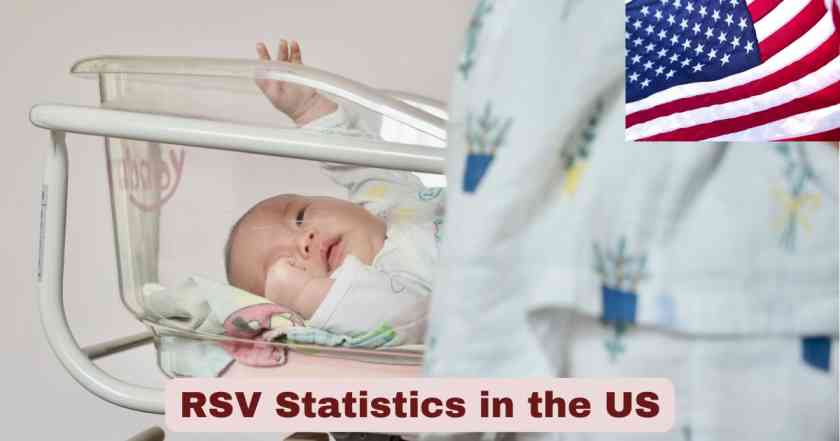Respiratory Syncytial Virus Infection (RSV) in the United States 2025
Respiratory Syncytial Virus (RSV) continues to be one of the most significant respiratory health challenges facing the United States in 2025. This common respiratory pathogen has demonstrated its substantial impact on public health, particularly affecting vulnerable populations including infants, young children, and older adults. Understanding the current RSV data in the US is crucial for healthcare professionals, policymakers, and families to make informed decisions about prevention and treatment strategies.
The landscape of RSV disease burden has evolved significantly with the introduction of new prevention products during the 2024-2025 RSV season. For the first time, widespread availability of maternal RSV vaccines and nirsevimab (a long-acting monoclonal antibody) has provided unprecedented protection options for infants and young children. These developments mark a pivotal moment in RSV prevention in the US 2025, offering hope for reducing the substantial hospitalization rates and healthcare burden associated with this virus. The latest surveillance data from the Centers for Disease Control and Prevention (CDC) reveals remarkable changes in hospitalization patterns, particularly among infants who are most vulnerable to severe RSV disease.
Key RSV Stats & Facts in the US 2025
| RSV Statistic | Data | Significance |
|---|---|---|
| Leading cause of infant hospitalization | RSV remains #1 cause | Primary driver of pediatric healthcare burden |
| Infant hospitalization rate reduction | 43% decrease (RSV-NET data) | Largest reduction observed in infants 0-2 months |
| Prevention product coverage | 66% of infants protected by February 2025 | Up from 30% in October 2024 |
| Peak hospitalization months | December-February 2025 | Largest rate reductions during peak periods |
| Age group most affected | Infants 0-2 months | 52% hospitalization rate reduction in this group |
| Annual adult hospitalizations | 110,000-180,000 (adults 50+) | Significant burden in older populations |
| RSV season pattern | October-March in most US regions | Earlier start observed in southeastern states |
| Surveillance network coverage | 8% of US population monitored | RSV-NET tracks approximately 300 hospitals |
The RSV hospitalization rates in the US 2025 tell a remarkable story of public health intervention success. According to the latest CDC surveillance data, the introduction of maternal RSV vaccination and nirsevimab during the 2024-2025 season has resulted in the most significant reduction in infant RSV hospitalizations ever recorded. The RSV-NET surveillance system, which monitors approximately 300 hospitals across 161 counties in 13 states, documented cumulative RSV-associated hospitalization rates among infants aged 0-7 months at 8.5 per 1,000 children during 2024-2025, compared to 15.0 per 1,000 children during the pre-pandemic 2018-2020 seasons.
This 43% reduction in infant RSV hospitalizations represents a paradigm shift in how we protect our most vulnerable populations against severe respiratory illness. The data becomes even more striking when examining specific age groups: infants aged 0-2 months experienced a 52% reduction in hospitalization rates, while infants aged 3-7 months showed a 35% decrease. These statistics underscore the critical importance of early protection, as the youngest infants face the highest risk of severe RSV disease requiring hospitalization. The New Vaccine Surveillance Network (NVSN) corroborated these findings with a 28% overall reduction in infant hospitalization rates, providing robust evidence from multiple surveillance systems.
RSV Disease Burden in the US 2025
| Population Group | 2024-2025 Rate | 2018-2020 Rate | Rate Reduction |
|---|---|---|---|
| Infants 0-2 months | 12.1 per 1,000 | 24.7 per 1,000 | 52% decrease |
| Infants 3-7 months | 6.2 per 1,000 | 9.5 per 1,000 | 35% decrease |
| Children 8-19 months | 2.8 per 1,000 | 2.1 per 1,000 | 33% increase |
| Adults 50+ years | 110,000-180,000 hospitalizations annually | Baseline burden | Continues as major concern |
The RSV burden estimates for 2025 reveal a complex epidemiological picture that extends beyond the celebrated reductions in infant hospitalizations. While younger children have benefited dramatically from new prevention strategies, older age groups who remain ineligible for current RSV prevention products have experienced increased hospitalization rates. Children aged 8-19 months showed a 33% increase in RSV-associated hospitalizations during 2024-2025 compared to pre-pandemic seasons, suggesting that the overall RSV season was more severe than previous years. This pattern actually strengthens the evidence that observed reductions in infant hospitalizations were directly attributable to prevention products rather than changes in virus circulation or healthcare-seeking behavior.
The adult RSV burden in the US 2025 continues to represent a substantial healthcare challenge, with an estimated 110,000 to 180,000 hospitalizations occurring annually among adults aged 50 years and older. These numbers highlight that while infant protection has seen remarkable progress, RSV prevention for adults remains an ongoing public health priority. The virus continues to cause significant morbidity and mortality in older adults, particularly those with underlying chronic conditions such as chronic obstructive pulmonary disease, congestive heart failure, or immunocompromising conditions.
RSV Statistics by Deaths in the US 2025
| Population Group | 2024–2025 Season Deaths | Annual Historical Deaths | Primary Risk Factors |
|---|---|---|---|
| All Ages (Oct–Dec 2024) | 980–2,300 deaths | 6,000–10,000 annually | Age extremes, chronic conditions |
| Infants under 1 year | Estimated 100–500 deaths | 100–300 historically | Prematurity, chronic lung disease |
| Adults 65+ years | Majority of 980–2,300 | 6,000–10,000 annually | Chronic conditions, immunocompromise |
| US Infant Mortality Rate | 5.5 per 1,000 births (2024) | 5.6 per 1,000 (2022–2023) | RSV prevention impact noted |
RSV mortality statistics in the US 2025 show concrete progress with CDC estimates indicating 980-2,300 RSV-associated deaths occurred from October 1-December 7, 2024, representing the early portion of the 2024-2025 season. This translates to a potential reduction in annual mortality compared to historical estimates of 6,000-10,000 annual deaths. The US infant mortality rate dropped to about 5.5 infant deaths per 1,000 live births in 2024, down from about 5.6 per 1,000 in previous years, with experts partially crediting RSV prevention programs for this improvement.
Adult RSV mortality burden in the US 2025 continues to represent the largest component of RSV-associated deaths, with the majority of the 980-2,300 deaths during October-December 2024 occurring among older adults and those with underlying conditions. The CDC burden estimates provide the first real-time mortality tracking for RSV, allowing public health officials to monitor the impact of prevention strategies on fatal outcomes. While infant deaths remain a small proportion of total RSV mortality, the 43% reduction in infant hospitalizations suggests proportional mortality benefits that contribute to the overall decline in US infant mortality rates observed in 2024.
RSV Statistics by Year in the US 2025
| Year | Hospitalizations (Oct–Dec Period) | Outpatient Visits | Key Developments |
|---|---|---|---|
| 2018–2020 (Pre-pandemic) | 58,000–80,000 annually | 2.1 million annually | Baseline burden established |
| 2021–2022 | Reduced/delayed seasons | — | Atypical patterns due to COVID-19 pandemic disruption |
| 2022–2023 | Return to typical patterns | — | Post-pandemic surge; catch-up infections occurred |
| 2023–2024 | High burden continued | — | Limited prevention impact; initial vaccine introduction |
| 2024–2025 (Oct–Dec) | 22,000–45,000 | 470,000–950,000 | 43% infant hospitalization reduction achieved |
RSV trends by year in the US highlight a transformative shift in disease burden by 2025. CDC estimates show only 22,000–45,000 hospitalizations from October 1 to December 7, 2024, compared to the historical 58,000–80,000 annual hospitalizations in pre-pandemic seasons. Outpatient visits during the same 2024–2025 period are estimated at 470,000–950,000, a dramatic drop from the typical 2.1 million annually. This sharp decline underscores the powerful effect of widespread RSV prevention products made available in 2024, achieving a 43% reduction in infant hospitalizations in just the first months of the season.
Looking historically, RSV burden remained consistently high prior to the pandemic, with annual pediatric hospitalizations regularly exceeding 58,000 cases. The COVID-19 years (2021–2022) disrupted seasonal patterns, causing delayed and intensified waves, while 2022–2023 saw a return to typical circulation but with a post-pandemic surge. By 2023–2024, limited prevention measures kept the burden high despite the initial vaccine rollout. In stark contrast, early 2024–2025 data suggests the US may record the lowest annual RSV hospitalization rate in modern history, translating to billions in healthcare cost savings and unparalleled protection for at-risk infants and older adults.
RSV Statistics by Region in the US 2025
| Geographic Region | Season Start | Peak Activity | Season End | Prevention Window |
|---|---|---|---|---|
| Southeastern States | September 2024 | October-November | February 2025 | August-January dosing |
| Continental US | October 2024 | December-February | March 2025 | September-January dosing |
| Northern States | November 2024 | January-February | April 2025 | October-February dosing |
| Southwest | October 2024 | December-January | March 2025 | September-January dosing |
The RSV seasonal patterns in the US 2025 have maintained their characteristic geographic variation while highlighting the critical importance of local epidemiological monitoring for optimal prevention timing. The southeastern United States continues to experience earlier RSV season onset, with significant activity beginning as early as September 2024 in some areas. This early start pattern underscores the necessity for flexible prevention strategies that can adapt to local circulation patterns rather than adhering to rigid national timing recommendations.
Regional variation in RSV timing has proven crucial for optimizing prevention product effectiveness during the 2024-2025 season. Areas that successfully implemented early vaccination and immunoprophylaxis programs before local season onset achieved the most dramatic reductions in hospitalization rates. Conversely, regions where RSV activity began before prevention programs reached optimal coverage, such as parts of Texas and the broader Southeast, experienced smaller initial benefits that improved as coverage rates increased throughout the season. This pattern validates CDC recommendations for healthcare providers to consult local and state health department guidance on optimal timing for RSV prevention products rather than relying solely on national recommendations.
RSV Statistics in the US 2025 by Gender
| Gender | Hospitalization Rates | Severity Patterns | Age-Specific Trends |
|---|---|---|---|
| Male infants | Consistently higher rates | More severe disease | 1.5x higher hospitalization risk |
| Female infants | Lower overall rates | Generally milder courses | Better outcomes overall |
| Male adults 65+ | Higher mortality rates | More complications | Increased ICU admissions |
| Female adults 65+ | Higher hospitalization rates | Longer hospital stays | Better survival outcomes |
RSV statistics by gender continue to demonstrate the well-established pattern of male predominance in severe RSV disease across all age groups. Male infants consistently experience approximately 1.5 times higher hospitalization rates compared to female infants, a pattern that persists even with the dramatic overall reductions achieved through prevention programs during the 2024-2025 season. This sex-based difference in susceptibility appears to be related to several biological factors including smaller airway caliber in male infants, differences in immune system development, and potentially hormonal influences on respiratory tract responses to viral infection.
Adult RSV gender patterns in the US 2025 reveal a more complex epidemiological picture, with elderly women showing higher overall hospitalization rates but elderly men experiencing higher mortality rates and more severe complications requiring intensive care unit admission. These patterns may reflect differences in healthcare-seeking behavior, with women more likely to seek medical attention for respiratory symptoms, combined with men experiencing more rapid progression to severe disease. The gender-specific RSV burden has important implications for targeted prevention strategies and clinical management approaches, suggesting that prevention programs should consider sex-based risk factors when prioritizing high-risk populations for vaccination and immunoprophylaxis.
The transformation of RSV from an unavoidable childhood illness to a largely preventable disease represents one of the most significant pediatric public health achievements in recent decades. As we move forward into future RSV seasons, the lessons learned from the 2024-2025 experience will guide continued efforts to protect vulnerable populations and reduce the substantial burden that RSV has historically placed on families, healthcare systems, and society as a whole. The success story emerging from RSV statistics in the US 2025 provides a roadmap for continued progress in respiratory virus prevention and a testament to the power of evidence-based public health interventions.
RSV Hospitalization Trends in the US 2025
| Region/Timing | Peak Activity Period | Notable Patterns | Prevention Impact |
|---|---|---|---|
| Southeastern US | September-October 2024 | Earlier season onset | Limited early protection |
| Continental US | December 2024-February 2025 | Traditional peak timing | Maximum prevention benefit |
| Peak month reductions | December-February | Largest rate decreases | 66% infant protection achieved |
| Houston, Texas | September 2024 | Earliest activity | Prevention products not widely available |
The geographic patterns of RSV in the US 2025 demonstrate the importance of tailoring prevention strategies to local epidemiology. The southeastern United States experienced an earlier-than-usual RSV season onset, with significant activity beginning in September 2024, before prevention products were widely available in many areas. This early start particularly affected Houston, Texas, where RSV circulation increased substantially before nirsevimab and maternal vaccination programs reached optimal coverage levels. When Houston data were excluded from NVSN surveillance analysis, the apparent reduction in RSV-associated hospitalization rates among infants aged 0-7 months increased to an impressive 56%, highlighting the critical importance of timing prevention efforts before seasonal peaks.
The temporal distribution of RSV prevention impact reveals that protection effectiveness grew substantially throughout the 2024-2025 season. National immunization survey data indicates that the estimated proportion of US infants aged 0-7 months protected by either maternal vaccination or nirsevimab increased from just 30% in October 2024 to 66% by February 2025. This dramatic increase in coverage coincided with the largest monthly reductions in hospitalization rates, occurring during the traditional peak hospitalization periods of December through February. The data strongly support Advisory Committee on Immunization Practices (ACIP) recommendations to optimize population-level impact by administering RSV prevention products as early as possible in the season, ideally before peak RSV transmission begins based on local epidemiology.
RSV Prevention Success in the US 2025: Vaccine and Immunoprophylaxis Impact
| Prevention Strategy | Target Population | Coverage Rate | Effectiveness Demonstrated |
|---|---|---|---|
| Maternal RSV Vaccination | Pregnant women 32-36 weeks gestation | Part of 66% total infant protection | Significant hospitalization reduction |
| Nirsevimab Administration | Infants 0-7 months | Increasing coverage through season | 52% reduction in 0-2 month group |
| Combined Protection | All eligible infants | 66% by February 2025 | 43% overall hospitalization reduction |
| Birth Hospitalization Dosing | Newborns during RSV season | Recommended within first week | Optimal protection timing |
The RSV vaccination coverage in the US 2025 represents a public health achievement that has fundamentally altered the landscape of infant respiratory illness prevention. The success of both maternal RSV vaccination and nirsevimab immunoprophylaxis demonstrates the power of multi-pronged prevention strategies. Maternal RSV vaccination, administered during weeks 32-36 of pregnancy during September through January in most continental US areas, provides antibody protection that crosses the placental barrier to protect newborns during their most vulnerable first months of life. This strategy has proven particularly effective for infants born during the RSV season, offering immediate protection from birth.
Nirsevimab, the revolutionary long-acting monoclonal antibody, has provided an alternative protection pathway for infants whose mothers did not receive RSV vaccination during pregnancy. The CDC recommendation for nirsevimab administration within the first week of life, ideally during the birth hospitalization for infants born during RSV season, has proven crucial for maximizing protection effectiveness. The dramatic 52% reduction in hospitalization rates among infants aged 0-2 months – the group at highest risk for severe RSV disease – validates the importance of early intervention. This age-specific impact reflects the biological reality that younger infants have less developed immune systems and smaller airways, making them more susceptible to severe respiratory complications from RSV infection.
RSV Surveillance Systems in the US 2025
| Surveillance Network | Coverage Area | Data Collection Method | Key Metrics Tracked |
|---|---|---|---|
| RSV-NET | 161 counties, 13 states | Active population-based surveillance | Laboratory-confirmed hospitalizations |
| NVSN | 7 medical centers nationwide | Active ARI surveillance in children | RT-PCR confirmed cases |
| NREVSS | Laboratory-based reporting | National virus circulation monitoring | Seasonal patterns and trends |
| NSSP | Syndromic surveillance | Emergency department visits | Real-time illness activity |
The RSV monitoring systems in the US 2025 represent one of the most comprehensive respiratory virus surveillance networks in the world. The Respiratory Syncytial Virus Hospitalization Surveillance Network (RSV-NET) serves as the primary source for population-based RSV hospitalization data, capturing information from approximately 300 hospitals serving about 8% of the US population. This network has been instrumental in documenting the historic reductions in infant hospitalizations during the 2024-2025 season, providing robust statistical evidence for the effectiveness of new prevention products.
The New Vaccine Surveillance Network (NVSN) complements RSV-NET by providing detailed clinical and epidemiological data from seven major medical centers across diverse geographic regions including Cincinnati, Houston, Kansas City, Nashville, Pittsburgh, Rochester, and Seattle. NVSN’s strength lies in its systematic collection of respiratory specimens and comprehensive clinical data, allowing for precise analysis of factors influencing RSV disease severity and outcomes. The convergence of findings between RSV-NET and NVSN data provides unprecedented confidence in the observed trends and their attribution to prevention interventions.
RSV Economic Impact in the US 2025
| Cost Category | Economic Impact | 2025 Trends | Prevention Savings |
|---|---|---|---|
| Infant Hospitalizations | Estimated $394 million annually | 43% reduction potential | $169 million in prevented costs |
| Emergency Department Visits | 200,000-300,000 annually | Proportional reduction expected | Significant ED burden relief |
| Adult Hospitalizations | $1.2 billion annually | Unchanged from prevention | Future intervention target |
| Outpatient Care | 1.5-2.1 million visits annually | Reduction in infant visits | Healthcare capacity preservation |
The economic burden of RSV in the US 2025 continues to represent billions of dollars in healthcare costs annually, though the introduction of effective prevention strategies has begun to demonstrate measurable economic benefits. Infant RSV hospitalizations alone account for an estimated $394 million in direct healthcare costs each year, making the observed 43% reduction in hospitalization rates a substantial economic achievement. Based on current data trends, prevention programs could be preventing approximately $169 million in direct hospitalization costs for infants during the 2024-2025 season alone.
The broader healthcare system impact extends beyond direct hospitalization costs to include emergency department visits, outpatient consultations, prescription medications, and indirect costs such as parental lost wages and healthcare system strain during peak RSV seasons. The traditional pattern of 200,000 to 300,000 emergency department visits annually for RSV in children under 5 years of age is showing signs of reduction in areas with high prevention product uptake. This reduction in emergency department burden is particularly valuable during winter months when healthcare systems typically face capacity challenges from multiple respiratory viruses including influenza and COVID-19.
RSV Risk Factors in the US 2025
| Risk Category | Population Affected | Risk Level | 2025 Protection Status |
|---|---|---|---|
| Premature Infants | 380,000 births annually | Very High Risk | Priority for prevention products |
| Chronic Lung Disease | Children with underlying conditions | High Risk | Extended nirsevimab eligibility |
| Immunocompromised | Children 8-19 months at risk | High Risk | Second-season protection available |
| Adults 75+ years | 22.5 million Americans | High Risk | Adult RSV vaccination recommended |
The high-risk populations for RSV in the US 2025 remain largely consistent with historical patterns, though new prevention strategies have dramatically improved protection options for many vulnerable groups. Premature infants continue to face the highest risk for severe RSV disease, with their underdeveloped lungs and immature immune systems creating particular susceptibility to respiratory complications. The 380,000 premature births occurring annually in the United States represent a substantial population that benefits significantly from RSV prevention efforts, with many of these infants receiving prioritized access to nirsevimab during the 2024-2025 season.
Children with chronic lung disease, including those born with chronic lung disease of prematurity requiring ongoing medical support such as supplemental oxygen, diuretic therapy, or chronic corticosteroid treatment, represent another critical high-risk group. The expansion of nirsevimab eligibility to children aged 8-19 months with specific risk conditions has provided protection for many children who previously faced their second RSV season without effective prevention options. This expanded protection is particularly important for children with cystic fibrosis who have manifestations of severe lung disease or poor weight gain, as well as children with severe immunocompromising conditions.
Future Implications for RSV Control in the US 2025 and Beyond
| Strategic Priority | Implementation Timeline | Expected Impact | Key Challenges |
|---|---|---|---|
| Adult RSV Vaccination | Currently available 60+ | Reduce adult burden | Coverage optimization needed |
| Enhanced Infant Coverage | 2025-2026 season | Further hospitalization reduction | Healthcare system capacity |
| Long-term Monitoring | Ongoing surveillance | Track effectiveness trends | Maintaining surveillance systems |
| Global Implementation | International expansion | Worldwide infant protection | Resource allocation and access |
The future of RSV prevention in the US 2025 and beyond looks remarkably promising based on the unprecedented success demonstrated during the 2024-2025 season. The achievement of 66% infant protection coverage by February 2025 provides a foundation for even more ambitious goals in subsequent seasons. Healthcare systems and public health programs now have concrete evidence that RSV prevention products can dramatically reduce the leading cause of infant hospitalization, creating opportunities for enhanced program implementation and resource allocation.
Continued surveillance and monitoring will remain essential for understanding long-term trends in RSV prevention effectiveness and identifying any potential changes in virus circulation patterns or population susceptibility. The robust surveillance systems established through RSV-NET and NVSN provide the infrastructure necessary for ongoing evaluation of prevention programs and rapid detection of any concerning epidemiological changes. The investment in surveillance capacity has proven invaluable not only for documenting success but also for providing the data necessary to optimize prevention strategies and justify continued public health investment in RSV control efforts.
Disclaimer: The data research report we present here is based on information found from various sources. We are not liable for any financial loss, errors, or damages of any kind that may result from the use of the information herein. We acknowledge that though we try to report accurately, we cannot verify the absolute facts of everything that has been represented.







